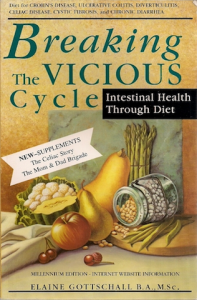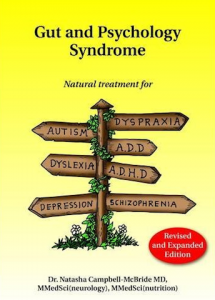The Specific Carbohydrate Diet (SCD) has a number of problems associated with the diet. Even though most people feel great on the diet, they have problems staying with the program long term. I hope this posting will help newcomers to the diet overcome these common pitfalls.
The SCD restricts all processed foods and food additives. This in itself can make a big change in a person’s health. The number of chemical additives put in processed foods has increased at an alarming rate in the last 50 years. There is a great amount of controversy about the safety of these additives. Nevertheless, these additives are everywhere. Avoiding additives means avoiding all processed food and any food produced in a standard restaurant. To the sensitive person even a minute amount of the problem substance can cause great damage.
The SCD is not necessarily a low carbohydrate diet but compared to the Standard American Diet (SAD) it will be lower in fiber and carbohydrates. Grains, legumes and beans are by far the greatest source of indigestible fiber and carbohydrates in a healthy person’s diet. By removing these foods and changing nothing else, your diet will become lower in fiber and carbohydrate.
1. The Crash Landing is constipation. A vast majority of the volume of a healthy bowel movement is bacteria, not indigestible fiber. Constipation that is caused by the reduction of dietary fiber is a symptom of gut dysbiosis. Gut dysbiosis is a lack of healthy intestinal bacteria. There are a number of ways to increase gut flora. Start by introducing lacto-fermented foods and drinks into your daily diet. This is a very inexpensive way to get probiotics and will solve the problem for most people. If whole, fermented foods do not work within a month or two consider trying therapeutic probiotics.
You might be wondering why I am not recommending eating supplemental fiber. Fiber is good for us, right? I would suggest reading Fiber Menace by Konstantin Monastyrsky and coming to your own decision on the safety of fiber. It is a funny book that will make you forever look at the contents of your toilet in a new way.
2. Carb Addiction is a common symptom that will appear from nowhere. When a person starts the SCD there will be a sudden reduction of the person’s normal carbohydrate load. This reduction of carbohydrates will induce an unbelievably strong force which will drive a craving to eat the very foods that are likely to be causing the problem. The person’s “gut flora” will be calling for their feeding of carbohydrate using the “gut brain”. The gut brain is very primitive part of our nervous system. It is completely nonverbal, causes action without higher thinking, and is the powerful force behind craving and addiction.
The gut brain cannot be controlled. The only way is to live through the “die-off” of the bacterial strains causing the addictive behavior. The die-off can take a week or a month. It is horrible to live through but there is a world on the other side without craving and addiction.
Carb addiction is a symptom of gut dysbiosis and gut flora imbalance. Carb addiction is the beginning of the long road to diabetes. If a person has a problem with yeast infections, hypoglycemia or diabetes, it would be wise to go low-carbohydrate with the SCD. Please see Life Without Bread for a low-carbohydrate protocol that works with over 90% of people.
3. Eating Out is very challenging. High end restaurants that make all the food in-house might be safe. I still have to be very careful and I never know if the waiter has transmitted the information to the kitchen. I have heard of people who do a lot of traveling making up a business card with their dietary restrictions. Generally, I do not eat out. When I am traveling I bring my own food in a cooler and have a bin full of dried food. I eat my dried stores and shop at local grocery stores for fresh foods.
The SCD will cause social and family problems. The people who love me are just happy to see me well again. They help make the diet easier by their acceptance. Not everyone will be as supportive. It is my responsibility to take care of myself and do what is necessary. What I put in my mouth is completely under my control. No amount of pressure from the outside can change that fact. Just watch out for the “gut brain”!


